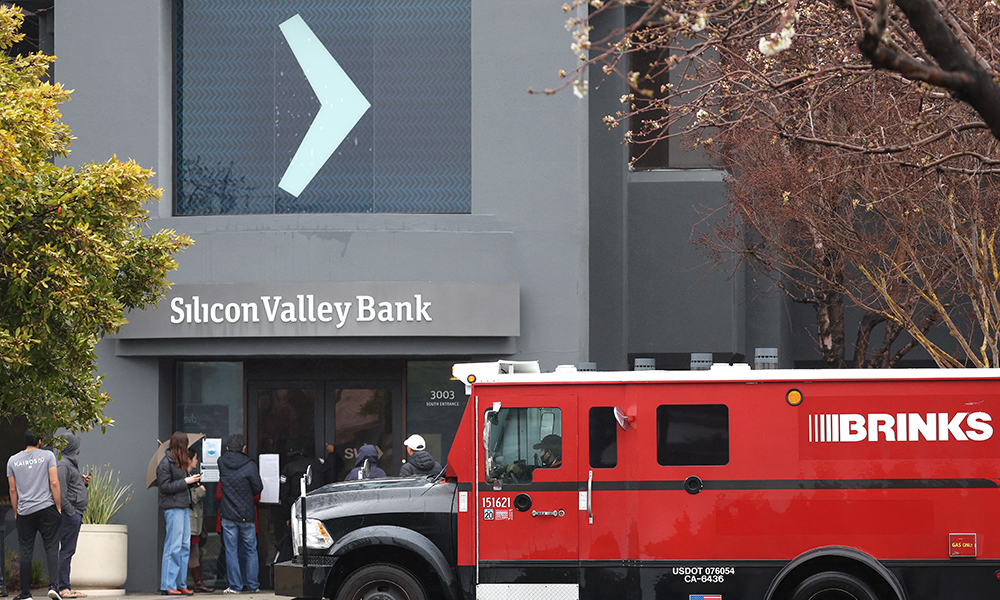硅谷银行突然倒闭引发恐慌,但有人在几个月前就看到了警告信号

在短短48小时内,硅谷的坚定支持者硅谷银行(Silicon Valley Bank)突然倒闭,让创始人、风投、银行家和报道他们的记者们的世界彻底颠覆。美国加州监管部门的申报文件显示,3月10日,投资者和储户试图取走在该银行的存款420亿美元。虽然银行挤兑令大多数人感到意外,但《财富》杂志采访的一位做空投资者早在几个月前就看到了警告信号。正如我们的编辑在《财富》杂志的文章中所写:
加州金融监管部门于3月10日关闭硅谷银行,而在此之前不到一个小时,做空投资者戴尔·韦特劳费尔向我介绍了该银行的财务状况,并列举了他近几个月一直密切关注的一些指标。
韦特劳费尔是做空投资机构Bleecker Street Research的合伙人,该机构在今年1月开始做空硅谷银行。他表示:“我从未见过如此急转直下的情况。”
他所说的并非过去几天内发生的事件,例如硅谷银行宣布将通过出售股票融资超过20亿美元,不久之后银行挤兑迫使加州金融监管部门只能将其关闭。韦特劳费尔所说的是过去两年的情况。
韦特劳费尔解释称,在风投最繁荣的时候,该银行坐拥大量现金,其长期证券投资组合规模从170亿美元增长到980亿美元。硅谷银行投资的时机恰逢市场高点。
韦特劳费尔指出,如今,零利率已经不复存在,该银行长期证券投资组合亏损约150亿美元,这意味着如果硅谷银行打算通过出售长期投资组合中的债券释放资本,它可能不得不确认2022年年底报告的150亿美元未实现损失。
但2022年高利率的另外一个结果是,硅谷银行的利息支出达到令人难以置信的程度,一方面是由于美联储(Federal Reserve)加息导致该银行不得不提高向客户支付的利率,另外一个原因是2022年风险融资增速放缓。这导致该银行的无息存款流入规模低于流出规模。这是因为初创公司和其他客户都在烧钱。硅谷银行的存款结构因此发生了显著变化。2022年,无息存款减少450亿美元,导致该银行不得不用高成本负债取代之前低成本的资金来源。
截至2021年12月,硅谷银行的存款利息支出为6,200万美元。到2022年12月达到8.62亿美元。韦特劳费尔预测,到今年年底,存款利息支出将达到近40亿美元。
但可以说,即使获利的一方也不会欢呼雀跃。Bleecker Street Research的创始人克里斯·德洛斯表示:“这种事情显然不值得庆祝。”
将资金存在硅谷银行的大批初创公司,肯定认同这种情绪,正如《财富》的编辑在文章中写道:
在硅谷银行倒闭几个小时后,一位将资金存在该银行的初创公司创始人在私信中对《财富》杂志表示:“我们现在一头雾水,完全不知道接下来会发生什么。”
还有一位创始人通过私信告诉《财富》杂志:“我认为整个生态系统已经彻底瘫痪。”他们指出,目前的关键是“想方设法释放现金,保证能够为员工发工资。”
与此同时,还有风险投资者对其投资组合公司和创业圈的状况缺乏信心:一位风险投资者对《财富》杂志表示,“目前的问题是”无保险的初创公司资金的状况,以及这些资金是否被冻结。(财富中文网)
译者:刘进龙
审校:汪皓
在短短48小时内,硅谷的坚定支持者硅谷银行(Silicon Valley Bank)突然倒闭,让创始人、风投、银行家和报道他们的记者们的世界彻底颠覆。美国加州监管部门的申报文件显示,3月10日,投资者和储户试图取走在该银行的存款420亿美元。虽然银行挤兑令大多数人感到意外,但《财富》杂志采访的一位做空投资者早在几个月前就看到了警告信号。正如我们的编辑在《财富》杂志的文章中所写:
加州金融监管部门于3月10日关闭硅谷银行,而在此之前不到一个小时,做空投资者戴尔·韦特劳费尔向我介绍了该银行的财务状况,并列举了他近几个月一直密切关注的一些指标。
韦特劳费尔是做空投资机构Bleecker Street Research的合伙人,该机构在今年1月开始做空硅谷银行。他表示:“我从未见过如此急转直下的情况。”
他所说的并非过去几天内发生的事件,例如硅谷银行宣布将通过出售股票融资超过20亿美元,不久之后银行挤兑迫使加州金融监管部门只能将其关闭。韦特劳费尔所说的是过去两年的情况。
韦特劳费尔解释称,在风投最繁荣的时候,该银行坐拥大量现金,其长期证券投资组合规模从170亿美元增长到980亿美元。硅谷银行投资的时机恰逢市场高点。
韦特劳费尔指出,如今,零利率已经不复存在,该银行长期证券投资组合亏损约150亿美元,这意味着如果硅谷银行打算通过出售长期投资组合中的债券释放资本,它可能不得不确认2022年年底报告的150亿美元未实现损失。
但2022年高利率的另外一个结果是,硅谷银行的利息支出达到令人难以置信的程度,一方面是由于美联储(Federal Reserve)加息导致该银行不得不提高向客户支付的利率,另外一个原因是2022年风险融资增速放缓。这导致该银行的无息存款流入规模低于流出规模。这是因为初创公司和其他客户都在烧钱。硅谷银行的存款结构因此发生了显著变化。2022年,无息存款减少450亿美元,导致该银行不得不用高成本负债取代之前低成本的资金来源。
截至2021年12月,硅谷银行的存款利息支出为6,200万美元。到2022年12月达到8.62亿美元。韦特劳费尔预测,到今年年底,存款利息支出将达到近40亿美元。
但可以说,即使获利的一方也不会欢呼雀跃。Bleecker Street Research的创始人克里斯·德洛斯表示:“这种事情显然不值得庆祝。”
将资金存在硅谷银行的大批初创公司,肯定认同这种情绪,正如《财富》的编辑在文章中写道:
在硅谷银行倒闭几个小时后,一位将资金存在该银行的初创公司创始人在私信中对《财富》杂志表示:“我们现在一头雾水,完全不知道接下来会发生什么。”
还有一位创始人通过私信告诉《财富》杂志:“我认为整个生态系统已经彻底瘫痪。”他们指出,目前的关键是“想方设法释放现金,保证能够为员工发工资。”
与此同时,还有风险投资者对其投资组合公司和创业圈的状况缺乏信心:一位风险投资者对《财富》杂志表示,“目前的问题是”无保险的初创公司资金的状况,以及这些资金是否被冻结。(财富中文网)
译者:刘进龙
审校:汪皓
In a mere 48 hours the world has been turned upside down for founders, VCs, bankers and the journalists that write about them given the sudden failure of Valley stalwart Silicon Valley Bank. On March 10, investors and depositors tried to withdraw $42 billion in deposits from the bank, according to a California regulatory filing. And while most of the world was blindsided by a run on the bank, Fortune spoke to one short seller who saw the writing on the wall months ago. As our editor wrote in Fortune article:
Less than an hour before the California financial regulator closed Silicon Valley Bank’s doors on March 10, short seller Dale Wettlaufer is walking me through their financials, and laying out some metrics he’s been closely eyeballing for months.
“I’ve never seen a situation like this change so quickly,” says Wettlaufer, partner at the short-selling shop Bleecker Street Research, which opened its short position into SVB in January.
Wettlaufer wasn’t talking about the events of few days—when a bank run ushered the California financial regulator into its offices to close it down not long after SVB said it was raising more than $2 billion in capital through a share sale. No—Wettlaufer was referring to the last two years.
At the height of the venture boom, with the bank sitting on so much cash, its long-term securities portfolio grew from $17 billion to $98 billion, Wettlaufer explains. SVB invested that cash at the height of the market.
Now, interest rates aren’t zero any more, and that long-term securities portfolio is underwater by about $15 billion, Wettlaufer says, meaning that, if SVB had wanted to trade bonds within that long-term portfolio to free up capital, it might have had to recognize somewhere up to $15 billion in the unrealized losses it had reported at the end of 2022.
But another result of the newfound high-interest rates of 2022 was that Silicon Valley Bank’s own interest expenses would soar to absurd levels—both because of the Fed hikes, which necessitated SVB to up the interest rate it was paying to customers, but also because venture funding slowed down in 2022. That slowdown caused inflows of non-interest-bearing deposits at the bank to fall below outflows of those deposits. That’s because startups and other customers were burning cash. Because of this, the composition of SVB deposits changed drastically. Noninterest-bearing deposits fell $45 billion in 2022, forcing the bank to replace those with higher-cost liabilities than what had funded it previously.
As of Dec. 2021, SVB’s interest expense on its deposits was $62 million. By Dec. 2022, it was $862 million. By the end of this year, Wettlaufer was projecting it to be nearly $4 billion.
But suffice to say even those who are on the happier end of this trade aren’t cheering. “That is certainly not something to be celebrated,” Bleecker Street Research founder Chris Drose says.
The myriad startups who banked with SVB would certainly echo that sentiment, as our editors dug into article:
One startup founder who banked with SVB told Fortune in a private message that, hours after the bank failed, “Our heads are spinning over here—not entirely sure what happens next.”
Another founder told Fortune in a private message that “My take is the entire ecosystem is effectively paralyzed.” They said that the focus right now is freeing up “cash basically, however you can, and make sure you can pay your people.”
Meanwhile some venture capital investors are also unsure what’s going on with their portfolio companies and the startup community at large: One VC told Fortune that the question of what happens with startups’ funds over that insured amount and whether those funds are locked up is the “question of the day.”













